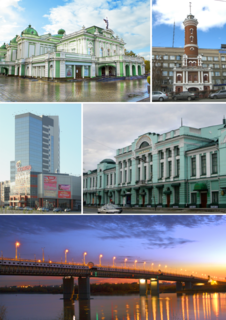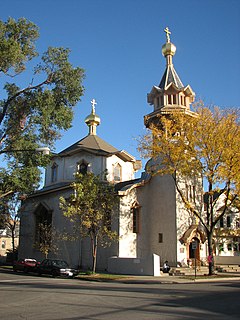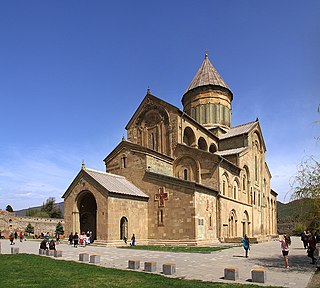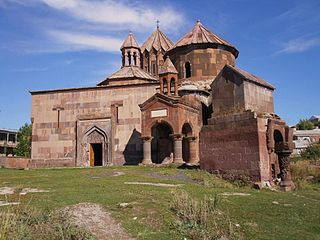
Omsk is the administrative center and largest city of Omsk Oblast, Russia. It is situated in southwestern Siberia, and has a population of over 1 million. Omsk is the second largest city in Siberia after Novosibirsk, and the ninth-largest city in Russia. It is an essential transport node, serving as a train station for the Trans-Siberian Railway and as a staging post for the Irtysh River.

St Paul's Cathedral is an Anglican cathedral in London that is the seat of the Bishop of London. The cathedral serves as the mother church of the Diocese of London. It is on Ludgate Hill at the highest point of the City of London and is a Grade I listed building. Its dedication to Paul the Apostle dates back to the original church on this site, founded in AD 604. The present structure, dating from the late 17th century, was designed in the English Baroque style by Sir Christopher Wren. Its construction, completed in Wren's lifetime, was part of a major rebuilding programme in the city after the Great Fire of London. The earlier Gothic cathedral, largely destroyed in the Great Fire, was a central focus for medieval and early modern London, including Paul's walk and St Paul's Churchyard, being the site of St Paul's Cross.

Saint Isaac's Cathedral or Isaakievskiy Sobor is a large architectural landmark cathedral that currently functions as a museum with occasional church services in Saint Petersburg, Russia. It is dedicated to Saint Isaac of Dalmatia, a patron saint of Peter the Great, who had been born on the feast day of that saint. It was originally built as a cathedral but was turned into a museum by the Soviet government in 1931 and has remained a museum ever since, with church services held in a side chapel since the 1990's. In 2017, the Governor of Saint Petersburg offered to transfer the cathedral back to the Russian Orthodox Church, but this was not accomplished due to the protests of St Petersburg citizens opposing the offer.

The Byzantine Revival was an architectural revival movement, most frequently seen in religious, institutional and public buildings. It incorporates elements of the Byzantine style associated with Eastern and Orthodox Christian architecture dating from the 5th through 11th centuries, notably that of Constantinople and the Exarchate of Ravenna.

The Trinity Cathedral, sometimes called the Troitsky Cathedral, in Saint Petersburg, Russia, is a formerly Russian Imperial Army Izmaylovskiy regiment Russian Orthodox church, an architectural landmark - a late example of the Empire style, built between 1828 and 1835 to a design by Vasily Stasov. It is located due south of the Admiralty on Izmaylovskiy Prospekt, not far from the Tekhnologichesky Institut Metro station.

Holy Trinity Orthodox Cathedral is the cathedral church of the Orthodox Church in America Diocese of the Midwest. It is one of only two churches designed by Louis Sullivan, one of the seminal architects of the late 19th and early 20th centuries. It is listed on the US National Register of Historic Places and is designated a Chicago Landmark.

The Svetitskhoveli Cathedral is an Orthodox Christian cathedral located in the historic town of Mtskheta, Georgia, to the northwest of the Georgian capital Tbilisi. A masterpiece of the Early and High Middle Ages, Svetitskhoveli is recognized by UNESCO as a World Heritage Site. It is currently the second largest church building in Georgia, after the Holy Trinity Cathedral.

Eastern Orthodox church architecture constitutes a distinct, recognizable family of styles among church architectures. These styles share a cluster of fundamental similarities, having been influenced by the common legacy of Byzantine architecture from the Eastern Roman Empire. Some of the styles have become associated with the particular traditions of one specific autocephalous Orthodox patriarchate, whereas others are more widely used within the Eastern Orthodox Church.

The Harichavank is 7th century Armenian monastery located near the village of Harich in the Shirak Province of Armenia. The village is 3 km southeast of the town of Artik.

St. Michael's Cathedral is a cathedral of the Orthodox Church in America Diocese of Alaska, at Lincoln and Maksoutoff Streets in Sitka, Alaska. The earliest Orthodox cathedral in the New World, it was built in the nineteenth century, when Alaska was under the control of Russia, though this structure burned down in 1966. After 1872, the cathedral came under the control of the Diocese of Alaska. It had been a National Historic Landmark since 1962, notable as an important legacy of Russian influence in North America and Southeast Alaska in particular.

The Grand Church of the Winter Palace in Saint Petersburg, sometimes referred to as the Winter Palace's cathedral, was consecrated in 1763. It is located on the piano nobile in the eastern wing of the Winter Palace, and is the larger, and principal, of two churches within the Palace. A smaller, more private church was constructed in 1768, near the private apartment in the northwest part of the wing. The Grand Church was designed by Francesco Rastrelli, and has been described as "one of the most splendid rooms" in the Palace. Today, the church is an unconsecrated exhibition hall of the State Hermitage Museum.

Russian-Byzantine architecture is a revivalist direction in Russian architecture and decorative and applied arts, based on the interpretation of the forms of Byzantine and Ancient Russian architecture. As part of eclecticism could be combined with other styles.

Vasily Petrovich Stasov was a famous Russian architect, born into a wealthy noble family: his father, Pyotr Fyodorovich Stasov, served in the patrimonial office, his mother, Anna Antipyevna, came from the prominent Priklonsky family.

The Lutheran Church of the Holy Catherine is a unique religious building of the 18th century, preserved in Omsk to this day, it was built for the needs of foreign Protestants, who worked in the governance of Siberian corps and Omsk fortress. The Lutheran Church of the Holy Catherine was built in 1790—1792

The Dormition Cathedral in Omsk is one of the largest churches in Siberia. Its fanciful design of many shapes and colors utilizes a plethora of elements from the Russian and Byzantine medieval architectural vocabulary. The main square of Omsk takes its name from the cathedral.

Noto Cathedral is a Roman Catholic cathedral in Noto in Sicily, Italy. Its construction, in the style of the Sicilian Baroque, began in the early 18th century and was completed in 1776. It is dedicated to Saint Nicholas of Myra, and has been the cathedral of the Diocese of Noto since the diocese's establishment in 1844.

The Metropolitan Cathedral of the Holy and Equal-to-the-Apostles Mary Magdalene is a Polish Orthodox cathedral, located at al. Solidarności 52 in Warsaw.

St Nicholas Russian Orthodox Cathedral is a heritage-listed cathedral at 330-334B Vulture Street, Kangaroo Point, Queensland, Australia. It was designed by Gregory Mechonoshin and Cavanagh and Cavanagh and built from 1935 to 1950s by B Robinson. It was added to the Queensland Heritage Register on 21 October 1992.

St. Nicholas Church is an Orthodox church in Novopyshminskoe village, Sverdlovsk Oblast.
St. Nicholas Church - is an Orthodox church in Klenovskoye village, Sverdlovsk oblast.



















